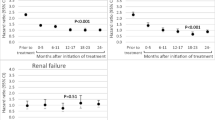Abstract
Summary
This study compared population hip fracture rates for women with a prior fragility fracture who were treated with first-generation versus second-generation bisphosphonate therapies. The observational study found that, relative to women treated with etidronate, a first-generation bisphosphonate, women treated with the second-generation therapies ‘alendronate’ or ‘risedronate’ were equally likely to be admitted to hospital for hip fracture. Our findings must be confirmed in large randomized head-to-head controlled trials.
Introduction
Few studies have examined hip fracture outcomes among users of first- versus second-generation bisphosphonates. We compared hip fracture rates among elderly women with a history of fracture dispensed first- and second-generation bisphosphonates, hypothesizing that hip fracture rates would be higher among users of first- versus second-generation bisphosphonates after adjusting for confounders.
Methods
Administrative data from Ontario, Canada from 01 April 1998 to 31 March 2002 was used to identify population-based bisphosphonate-naïve cohorts of subjects age 66 years and older initiated on first- (etidronate plus calcium; n = 19,127) or second-generation (alendronate or risedronate; n = 1,460) bisphosphonates. Multivariate Cox proportional hazard models were used for analysis.
Results
During over 23,000 person-years of follow-up, we observed 293 hospital admissions for first hip fracture. The unadjusted event rates yielded approximately 12.5 hospital admissions for hip fracture per 1,000 person-years of follow-up in each study group. Relative to the etidronate plus calcium group, females in the alendronate or risedronate group were equally likely to be admitted for hip fracture (adjusted rate ratio [aRR] = 1.0; 95% CI 0.6–1.6).
Conclusions
The findings of this study suggest similar rates of hip fracture between the first- and second-generation bisphosphonates when used continuously among elderly females with a prior history of fracture.
Similar content being viewed by others
References
Riggs BL, Melton LJ 3rd (1995) The worldwide problem of osteoporosis insights afforded by epidemiology. Bone 17(Suppl):505S–511S
Klotzbuecher CM, Ross PD, Landsman PB et al (2000) Patients with prior fractures have an increased risk of future fractures: a summary of the literature and statistical synthesis. J Bone Miner Res 15:721–739
Wu F, Mason B, Horne A et al (2002) Fractures between the ages of 20 and 50 years increase women’s risk of subsequent fractures. Arch Intern Med 162:33–36
NIH Consensus Development Panel on Osteoporosis Prevention, Diagnosis, and Therapy (2001) Osteoporosis prevention, diagnosis, and therapy. JAMA 285:785–795
Kado DM, Browner WS, Palermo L et al (1999) Vertebral fractures and mortality in older women: a prospective study. Study of Osteoporotic Fractures Research Group. Arch Intern Med 159:1215–1220
North American Menopause Society (2002) Management of postmenopausal osteoporosis: position statement of The North American Menopause Society. Menopause 9:84–101
Goeree R, O’Brien B, Pettitt D et al (1996) An assessment of the burden of illness due to osteoporosis in Canada. J Soc Obstet Gynaecol Can 18(Suppl):15–24
Kanis KA (1993) Osteoporosis and its consequences. Osteoporosis. Blackwell Science Ltd, Oxford, p 18
Cummings SR, Black DM, Thompson DE et al (1998) Effect of alendronate on risk of fracture in women with low bone density but without vertebral fractures: results from the Fracture Intervention Trial. JAMA 280:2077–2082
Black DM, Cummings SR, Karpf DB et al (1996) Randomised trial of effect of alendronate on risk of fracture in women with existing vertebral fractures. Fracture Intervention Trial Research Group. Lancet 348:1535–1541
McClung MR, Geusens P, Miller PD et al (2001) Effect of risedronate on the risk of hip fracture in elderly women. Hip Intervention Program Study Group. N Engl J Med 344:333–340
Harris ST, Watts NB, Genant HK et al (1999) Effects of risedronate treatment on vertebral and nonvertebral fractures in women with postmenopausal osteoporosis: a randomized controlled trial. Vertebral Efficacy with Risedronate Therapy (VERT) Study Group. JAMA 282:1344–1352
Reginster J, Minne HW, Sorensen OH et al (2000) Randomized trial of the effects of risedronate on vertebral fractures in women with established postmenopausal osteoporosis. Vertebral Efficacy with Risedronate Therapy (VERT) Study Group. Osteoporos Int 11:83–91
Storm T, Thamsborg G, Steiniche T et al (1990) Effect of intermittent cyclical etidronate therapy on bone mass and fracture rate in women with postmenopausal osteoporosis. N Engl J Med 322:1265–1271
Pols HA, Felsenberg D, Hanley DA et al (1999) Multinational, placebo-controlled, randomized trial of the effects of alendronate on bone density and fracture risk in postmenopausal women with low bone mass: results of the FOSIT study. Foxamax International Trial Study Group. Osteoporos Int 9:461–468
Ontario Ministry of Health and Long-Term Care (2005) Ontario Drug Benefit Formulary / Comparative Drug Index No. 39. http://www.health.gov.on.ca/english/providers/program/drugs/formulary/ed39_0_bk.pdf
Levy AR, O’Brien BJ, Sellors C et al (2003) Coding accuracy of administrative drug claims in the Ontario Drug Benefit database. Can J Clin Pharmacol 10:67–71
Schneeweiss S, Seeger JD, Maclure M, Wang PS, Avorn J, Glynn RJ (2001) Performance of comorbidity scores to control for confounding in epidemiologic studies using claims data. Am J Epidemiol 154:854–864
Bashford JN, Norwood J, Chapman SR (1998) Why are patients prescribed proton pump inhibitors? Retrospective analysis of link between morbidity and prescribing in the General Practice Research Database. BMJ 317:452–456
Recker RR, Gallagher R, MacCosbe PE (2005) Effect of dosing frequency on bisphosphonate medication adherence in a large longitudinal cohort of women. Mayo Clin Proc 80:856–861
Siris ES, Harris ST, Rosen CJ et al (2006) Adherence to bisphosphonate therapy and fracture rates in osteoporotic women: relationship to vertebral and nonvertebral fractures from 2 US claims databases. Mayo Clin Proc 81:1013–1022
Van den Boogaard CHA, Breekveldt-Postma NS, Borggreve SE, Goettsch WG, Goettsch WG, Herings RM (2006) Persistent bisphosphonate use and the risk of osteoporotic fractures in clinical practice: a database analysis study. Curr Med Res Opin 22:1757–1764
Author information
Authors and Affiliations
Corresponding author
Rights and permissions
About this article
Cite this article
Mamdani, M., Kopp, A. & Hawker, G. Hip fractures in users of first- vs. second-generation bisphosphonates. Osteoporos Int 18, 1595–1600 (2007). https://doi.org/10.1007/s00198-007-0446-5
Received:
Accepted:
Published:
Issue Date:
DOI: https://doi.org/10.1007/s00198-007-0446-5




